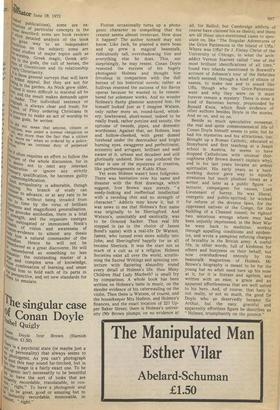he singular case
1(1 f Conan Doyle
Quigly
Doyle Ivor Brown (Hamish 'Itton £1.50) here is a psychical state (or maybe just a Fne°f Personality) that always seems to the Photogenic. As you can't photograph fattsotil this may sound far-fetched, but in Dliot the linage is a fairly exact one. To be but,enic isn't necessarily to be beautiful irlst„10 have the sort of looks that are teyz7ritlY recordable, translatable, in con" right." To have a photogenic soul h t° be great, good or amazing but to „listantly recordable, memorable, in right." Fiction occasionally turns up a photogenic character so compelling that his creator seems almost irrelevant. How does it happen? The author himself may not know. Like Jack, he planted a mere bean and up grew a magical beanstalk, ridiculously tall, overshadowing him and everything else he does. This, not surprisingly, he may resent. Conan Doyle resented the success of his hugely photogenic Holmes and thought him frivolous in comparison with the dull heroes of his historical novels; rather as Sullivan resented the success of his Savoy operas because he wanted to be remembered for solemner works. And no wonder Holmes's flashy glamour annoyed him. He himself looked just as I imagine Watson, only rather more so, round-faced, whiskery, lowbrowed, short-nosed, indeed to be really frank, rather porcine and snouty, the epitome of tweeds, pipes, and domestic worthiness. Against that, set Holmes, lean and hollow-cheeked, with great domed forehead under the deerstalker and bright burning eyes, swaggerer and perfectionist, eccentric and arrogant, brilliant and well aware of it, urbane and decadent and still gloriously undated. How one produced the other is one of the mysteries of creation, like parthenogenesis or Kubla Khan. Yet even Holmes wasn't born fullgrown. There was hesitation over his name and disaster with the first drawings, which suggest, Ivor Brown says sternly, "a seedy-looking and ineffectual intellectual with a receding chin and no strength of character." Addicts may know it, but it was news to me that Holmes's first name was originally to be Sheringf'ord. And Watson's, unsuitably and exotically, was to be Ormond Sacker. Then real life stepped in (as in the choice of James Bond's name) with a real-life Dr Watson, James, who turned even more solidly into John; and Sheringford happily for us all became Sherlock. It was the start not so much of a cult as of a religion. Holmes Societies exist all over the world, scrutinising the Sacred Writings and spinning conjecture with flattering absurdity round every detail of Holmes's life. How Many Children Had Lady Macbeth? is small fry by comparison. A whole book has been written on Holmes's taste in music, on the slender evidence of his caterwauling on the violin. Then there is Watson, of course, and the housekeeper Mrs Hudson, and Holmes's finances, and the exact location of 221 Upper Baker Street; there is Holmes's university (Mr Brown plumps, on no evidence at all, for Balliol, but Cambridge addicts of course have claimed his as theirs), and there are all those once-mentioned cases to spec ulate on, like 'The Singular Adventures of the Grice Pattersons in the Island of Uffa.' Where was Uffa? Dr J. Finlay Christ of the University of Chicago, in what the arch. addict Vernon Starrett called "one of -the most brilliant identifications of all time," found two islands mentioned in Boswell's account of Johnson's tour of the Hebrides which seemed, through a kind of elision of names, to make one and to sound like Uffa, though who the Grice-Pattersons were and why they were on it must forever remain a mystery. There is even a kind of Baconian heresy, propounded by Ronald Knox, which finds evidence of other authors besides Doyle in the stories. And so on, and so on. Beside so much speculative nonsense, the real and quite commonsensical life of Conan Doyle himself seems to pale; but he had his mysteries and his attractions, too. Brought up a Roman Catholic, educated at Stonyhurst and first teaching at a Jesuit school in Austria, he seems to have dropped Catholicism with unusual thor oughness (Mr Brown doesn't explain why), and in his last years became an ardent spiritualist. His early years as a hard working doctor gave way to equally strenuous but much plushier times as a writer, and later as a public figure — lecturer, campaigner for causes, Lord Lieutenant of Surrey. He was liberal, energetic and public-spirited; he worked for reform of the divorce laws, for the oppressed natives of the Congo, for the building of a Channel tunnel; he righted two notorious wrongs where men had been unjustly imprisoned; in the Boer War he went back to medicine, worked through appalling conditions and epidemics, and wrote a pamphlet refuting charges of brutality in the British army. A useful life, in other words, full of kindness for others and busyness on their behalf, but now overshadowed entirely by the beanstalk magnetism of Holmes. Mr Brown's biography is meant to be for the young but no adult need turn up his nose at it, for it is literate and ageless, and written with an ease, a grace and an apparent effortlessness that are well suited to his hero. And, of course, that hero is not really, or not so much, the good Dr Doyle who so deservedly became Sir Arthur, but the easy, graceful and apparently effortless figure he describes as "Holmes, triumphantly on the pounce."








































 Previous page
Previous page